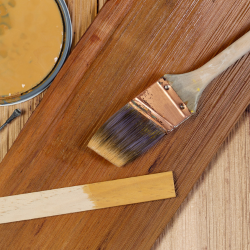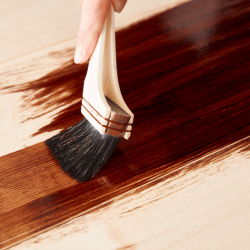Guide to Wood Stains & Finishes

A wood stain and wood finish are two different types of treatments that can be used on their own or together. These multi-purpose treatments can offer protection while enhancing the natural grain pattern of the wood. When exploring the differences between dark brown wood stains or durable oil-based wood finishes, it's best to consider your desired results and aesthetic preferences. Here's what you need to know:
Difference Between a Wood Stain & a Wood Finish

The two most popular applications for cabinet doors are a wood stain and a wood finish. While both are similar in design, they offer different results and serve different purposes for your project. Here's how they compare:
Wood Stain
A wood stain enhances the color and depth of the wood. Wood stains soak into the wood fibers, providing long-lasting depth and dimension. These treatments are available in various colors, including red wood stains, dark wood stains, and light wood stains. While wood stains don't provide any durability or protection, they can be paired with a wood finish for optimal results.
Types of Wood Stains
- Oil-Based Stains: Penetrate deeply into the wood and are best for vibrant colors. Oil-based stains take anywhere from 24 to 72 hours to fully dry.
- Water-Based Stains: Water-based stains typically dry in less than 24 hours but offer a lighter, less dramatic stain.
- Gel Stains: These stains are thicker and easier to apply to cabinet doors, making them ideal for beginners. It's also easier to get more even color coverage. Gel stains are best for vertical grain patterns or cabinet doors with intricate detailing.
Wood Finish
This protective coating sits on top of the wood's surface and doesn't penetrate the wood. The finish is designed to reduce wear and tear and improve the durability of the wood. Wood finishes don't change the color of the wood but can offer a different level of sheen. Most wood finishes come in a matte, glossy, or satin finish.
Types of Wood Finishes
- Polyurethane Finishes: A quick-drying wood finish that makes your cabinet doors more resistant to humidity and moisture. It's available in a variety of sheens and also subtly enhances the natural wood grain.
- Lacquer & Shellac: Fast-drying, durable, and glossy. Lacquer and shellac finishes are easy to apply but may require multiple coats to get the desired finish.
- Wax Finishes: These wood finishes are easy to apply and dry in less than an hour. It helps make the cabinet doors more resistant to scratches, dents, water, and everyday wear and tear.
- Oil Finishes: Tung oil and linseed oil finishes are durable and eco-friendly. However, oil-based finishes can take up to 72 hours to fully dry.
Factors to Consider When Choosing Stains & Finishes
When exploring different stain colors for wood and finishes for cabinet doors, you'll also want to consider.
- Your aesthetic preferences
- Durability needs (scratch-resistant, humidity-resistant, moisture-resistant)
- Wood type
- Maintenance and upkeep requirements
- Cabinet door use (indoors, outdoors, kitchen, bathroom, or commercial use)
- Desired finish (Dark wood stain, red wood stain, or black wood stain)
How to Apply Wood Stains & Finishes

Using wood stains and finishes is generally beginner-friendly. While some stains and finishes are more challenging to apply than others, understanding the basic application techniques can help you achieve a professional finish. Here's how to get started:
- Step one: Clean and prep the wood surface before application. Don't forget to sand the surface for a more even absorption.
- Step two: Apply wood stain directly to the wood surface with a cloth. Apply the stain in the same direction to avoid a streaky or uneven finish.
- Step three: Remove any excess stain and wait until the stain has completely dried to apply the finish.
- Step four: Apply your first coat of the wood finish.
- Step five: Sand between every coat to remove imperfections. Continue until you get your desired results.
Common Mistakes to Avoid
Staining and finishing wood can be a tedious process. To get the best results from both the stain and finish, follow the process step-by-step. You'll also want to avoid:
- Over-applying the stain or finish
- Pairing stains and finishes that have different solvent bases
- Skipping the sanding or cleaning process
- Forgetting to sand between the different wood finish coats
Choosing the Right Stain and Finish

Whether investing in new cabinet doors or giving your solid wood cabinets a makeover with a brown wood stain, the right treatments are crucial to achieving long-lasting, beautiful results.
Before you commit to a specific stain or finish, consider testing it on a scrap of wood or the back of your cabinet door. This will ensure you'll receive your desired results before committing to a larger project.
Whether you're considering a dark brown wood stain or black wood stain, Cabinet Door Factory offers a wide range of unfinished cabinet doors and high-quality wood species. All of our cabinet doors are custom-made and made to order. Once they ship and arrive, you can apply your favorite stain and finish, completely customizing the look before installation.
Explore our unfinished cabinet door collection today.
FAQs About Wood Stains & Finishes
Can I use a stain without a finish?
Yes, wood stains can be applied to a cabinet door without a wood finish. However, it won't protect against dents, scratches, or moisture. A wood finish helps seal the stain and preserve your cabinet door's integrity.
What’s the best finish for high-traffic areas?
Oil-based polyurethane is one of the most popular finishes for wood. It's durable and offers protection against scratches, dents, humidity, and moisture.
How long do wood stains and finishes typically last?
A high-quality wood stain can last anywhere from two to seven years. However, depending on the type of wood stain, you may need to touch up your cabinets every one or two years.


